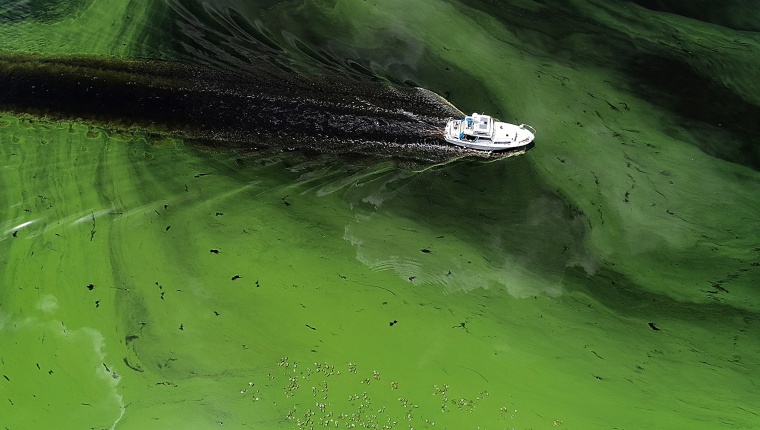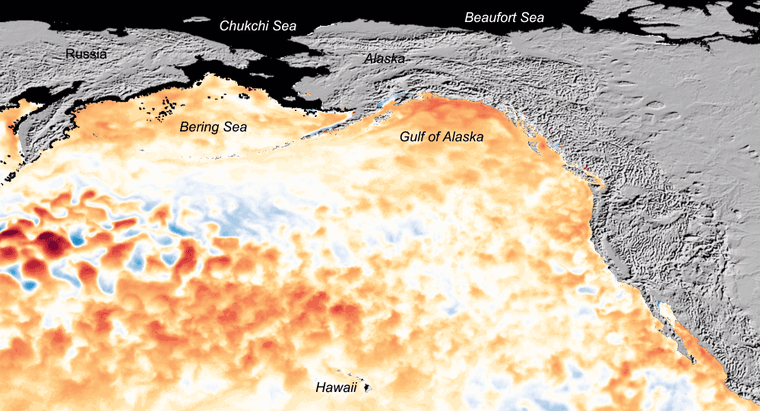As the World Warms, Harmful Algal Blooms Are on the Rise
(October 19, 2019) — Dangerous blooms of algae in freshwater lakes — like those that have caused environmental emergencies in Florida in recent years and in Toledo, Ohio in 2014 — are worsening as the Earth warms.
A new study shows that the blooms have become larger and more frequent in many of the world’s largest lakes since the 1980s, with lakes that have warmed the least over the past 30 years showing less intense algal blooms.
“That suggests that temperature — and therefore climate change — has a role to play in allowing lakes to recover or not” [from algal blooms], said study co-author Anna Michalak, an environmental engineer at the Carnegie Institution for Science in Stanford, California. “When temperatures get warmer, it can get in the way of management strategies that would otherwise have improved conditions in the lake.”
Algal, or phytoplankton, blooms are caused by the rapid growth of microscopic organisms in the water — often tiny plants but also some types of bacteria, such as blue-green algae (cyanobacteria).

A boat sails through a deepening algae bloom across the Caloosahatchee River in Labelle, Florida.
For the study, Michalak and Jeff Ho, an environmental engineer at the Carnegie Institution, and Nima Pahlevan, a remote sensing expert at NASA’s Goddard Space Flight Center in Greenbelt, Maryland, studied high-resolution satellite photographs of 71 large lakes in 33 countries on six continents.
A comparison of photos taken between 1984 and 2013 showed that algal blooms had increased in intensity in at least 22 lakes, including Florida’s Lake Okeechobee. Only six lakes worldwide showed a statistically significant decrease in blooms over that time.
There’s nothing abnormal about occasional algal blooms. They can occur naturally when a lake’s water warms in summer, and can be triggered when fertilizer applied to nearby land washes into lakes. Most disappear on their own within a few weeks. But under certain conditions they can grow out of control, spreading across hundreds of square miles and lasting for many months, suffocating fish and creating what’s known as a dead zone.
Algal blooms can also create high levels of toxins in the water, such as the cyanotoxins produced by blue-green algae. People and animals exposed to algal toxins by drinking contaminated water, bathing in it or even being splashed can suffer skin rashes, fevers, breathing problems and liver and kidney damage.
Algal blooms in coastal waters — like Florida’s annual red tides — cost the U.S. economy about $82 million each year, mainly from losses in fisheries and tourism. But algal blooms in lakes, which can be sources of drinking water as well as places for recreation and tourism, cause annual losses of more than $2 billion in the United States, according to a 2009 study.
Since 2016, toxic blooms of blue-green algae in Lake Okeechobee have caused an environmental crisis in Florida. A bloom in Lake Erie in 2014 forced Toledo to declare its water undrinkable for several days.
Thomas Frankovich, a biologist at Florida International University in Key Largo who wasn’t involved in the new study, praised it for its use of satellite imagery to assess algal blooms, instead of manually testing water samples from each lake. “It has a global perspective on phytoplankton blooms in lakes, something we really can’t get using land-based measurements,” he said.
When algal blooms do occur, they can be curbed by the application of chemical herbicides and other techniques. But often, it’s a matter of waiting until the algae die out.
As algal blooms become more common, water managers will need to take greater account of changes in lake temperatures and rainfall patterns, Ho said.
For Michalak, the best thing that can be done to prevent freshwater algal blooms is to limit climate change by cutting carbon emissions. But she agrees that lake management must become a higher priority. “We will need to be much more aggressive in how we manage lakes in order to achieve the same outcome as we would have had climate change not been occurring,” she said.
A Vast Heat Wave Is Endangering Sea Life in the Pacific Ocean. Is This the Wave of the Future?

A marine heat wave has formed in the northeastern Pacific Ocean, stretching roughly from the Gulf of Alaska south to California and west all the way to Hawaii (NOAA)
(October 16, 2019) — A vast region of unusually warm water has formed in the northeastern Pacific Ocean, and scientists are worried that it could devastate sea life in the area and fuel the formation of harmful algal blooms.
The broad swath of warm water, now known as the Northeast Pacific Marine Heat Wave of 2019, was first detected in early June. Now data from weather satellites and buoys show that it measures six to seven times the size of Alaska, which spans more than 600,000 square miles.
Given its size and location, the marine heat wave rivals a similar one that arose in 2014 and persisted for two years. That heat wave, known simply as “the blob,” occupied roughly the same region of the Pacific and became known for triggering widespread die-offs of marine animals including sea birds and California sea lions.
“The moms were going out to get food, but when they couldn’t find anything, they swam off and the babies were just left dying,” Andrew Leising, an oceanographer at the National Oceanographic and Atmospheric Administration’s Southwest Fisheries Science Center in La Jolla, California, said of the sea lions and their inability to find enough squid and fish to feed on.
“This year is most similar to 2014, and that was just the beginning of that last big heat wave,” Leising said. “We saw the maximum impacts in 2015, so it’s possible that next year we’ll be in for some really strong impacts.”
The marine heat wave formed as a result of a stubborn ridge of high pressure that lingered over Alaska this summer, which in turn resulted in unusually light winds over the Pacific.
“When you don’t have too much wind, warm temperatures can build up near the surface as a result of just the sun shining down on it,” said Gregory Johnson, an oceanographer at NOAA’s Pacific Marine Environmental Laboratory in Seattle.
Leising and Johnson agreed that more research is needed to understand what role climate change may play in the formation of marine heat waves. But it’s unusual for two such big events to occur in a relatively short timespan, according to Leising. “We’ve never had this before,” he said. “This is new.”
It’s likely that global warming will exacerbate heat waves in the future, given the excessive amounts of heat that oceans have absorbed in recent years, Johnson said. “From 1993 to 2018, the ocean has taken up heat at a rate of 350 terawatts — equivalent to five Hiroshima bombs a second exploding continuously from 1993 to the present,” he added.
With this trend of overall warming, climate change will likely make marine heat waves more intense and more frequent, said Nick Bond, a professor of atmospheric sciences at the University of Washington in Seattle.
“It’s easier to have a heat wave if you’re already starting with a higher base temperature,” Bond said. “If the floor is raised, it’s much easier to jump up and touch the ceiling.”
The current marine heat wave extends to an average depth of about 65 feet, with some parts of the Gulf of Alaska having elevated temperatures as far down as 260 feet. In comparison, the blob reached depths of 1,000 feet in some areas.
The extent of the warm water and how deep into the ocean it penetrates have enormous implications for marine life. Sea birds and sea lions may have been some of the most obvious victims of marine heat waves, but the negative consequences of unusually warm water can be seen throughout the marine food chain — from plankton, the tiny organisms that form the foundation of the food chain, to whales.
“Plankton that live in colder waters are generally fattier and more nutritious, so when the water warms up and species composition shifts, creatures higher in the food chain — sea birds, salmon, marine mammals — that rely on that fatty base of the food chain all suffer,” Johnson said.
Marine heat waves can also trigger overgrowths of microscopic algae, and these so-called algal blooms can be harmful to humans and animals. In 2015, commercial fisheries along the Pacific Coast were severely affected by a bloom that rendered fish and shellfish in the area unsafe for human consumption.
Bond said there have already been reports of algal blooms off the coast of Washington state tied to the current heat wave.
Scientists will be closely monitoring how the heat wave evolves over the coming weeks and months, and Bond said there have been signs that it has backed off slightly over the past month.
“There’s strong consensus in our climate models that it’ll decrease some,” he said. “What we’re still trying to hash out is the ecosystem’s response and what makes more of a difference: an extended, slightly warm period or an intense but shorter event.”
Posted in accordance with Title 17, Section 107, US Code, for noncommercial, educational purposes.